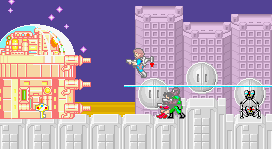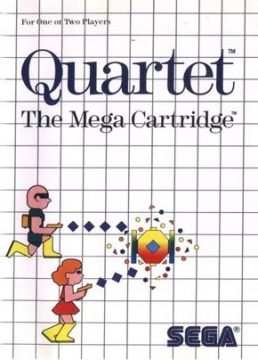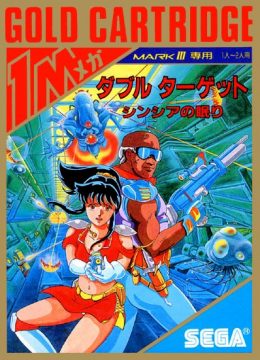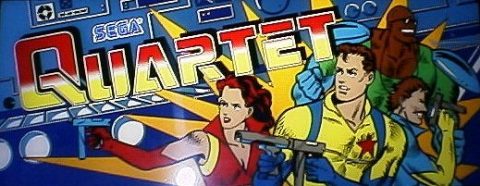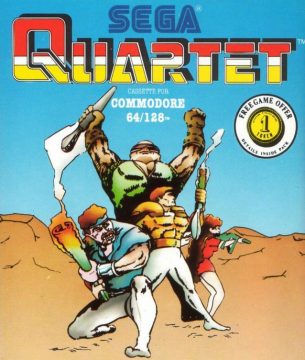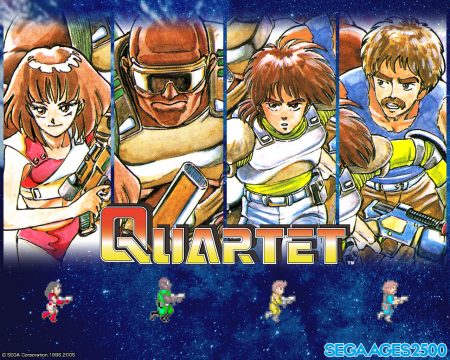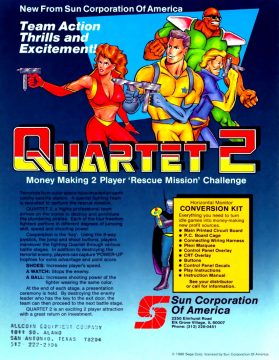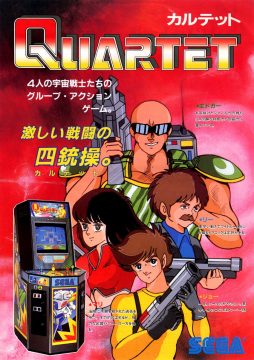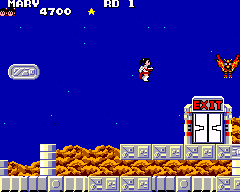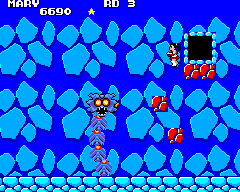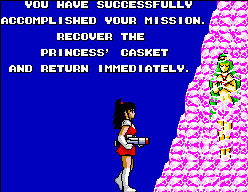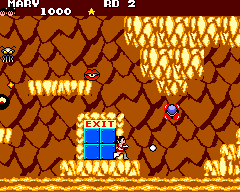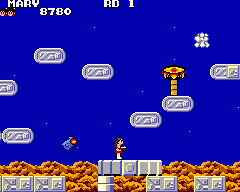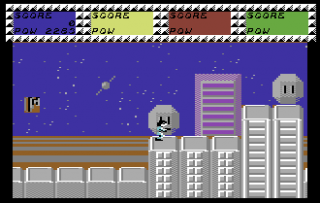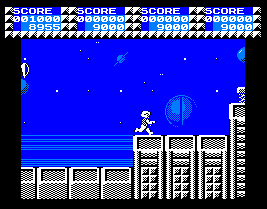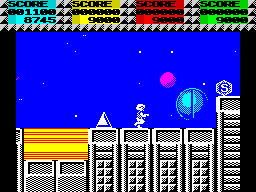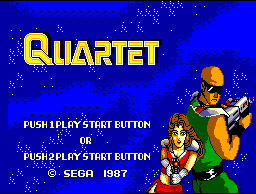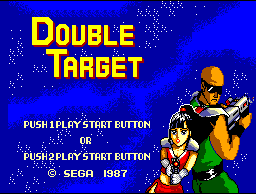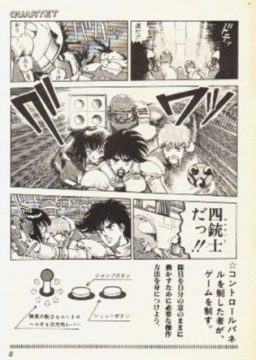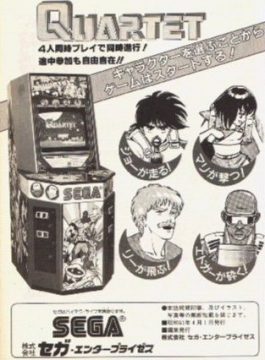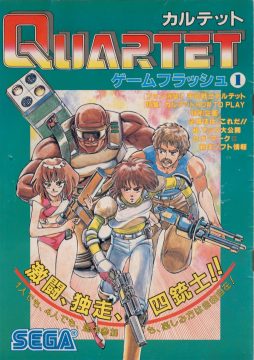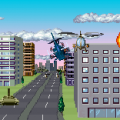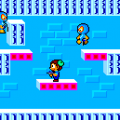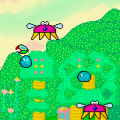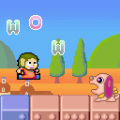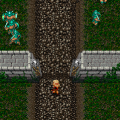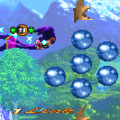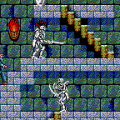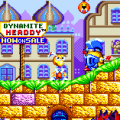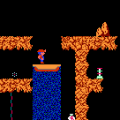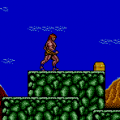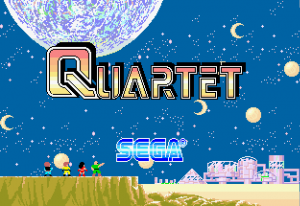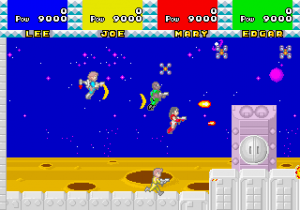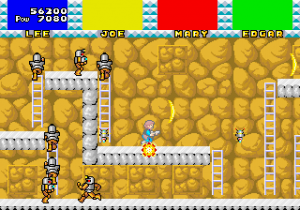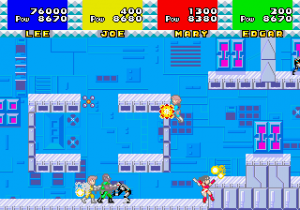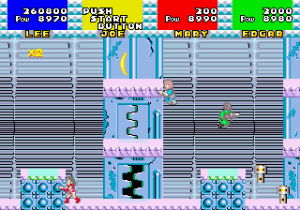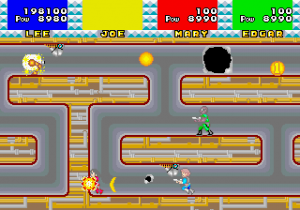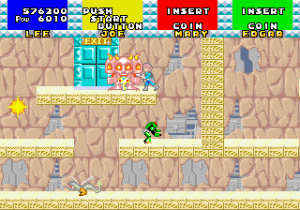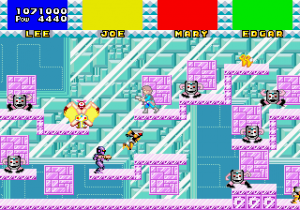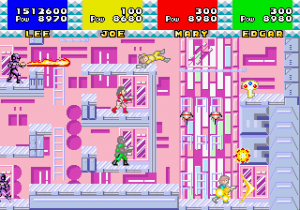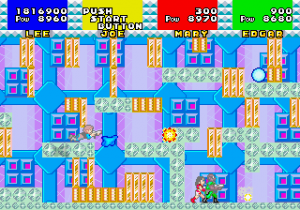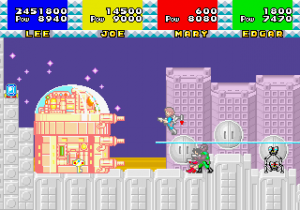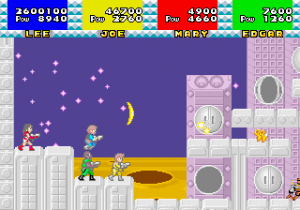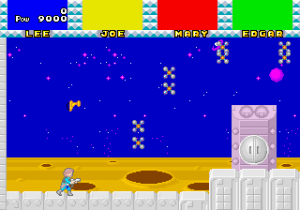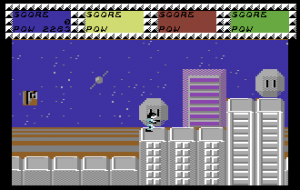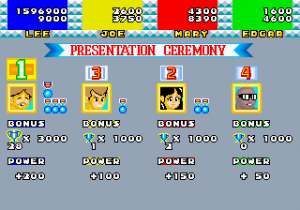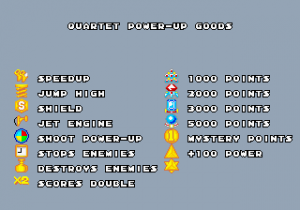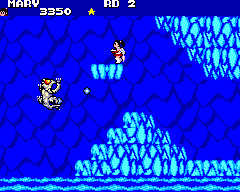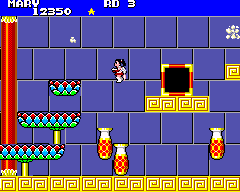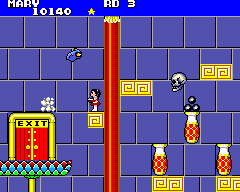Quartet seems to have come about by taking Midway’s Gauntlet and turning it into a side-scrolling shooter. While the basics – the four player simultaneous action, the draining life-meter, the monster generators – are all clearly inspired by it, Quartet drastically reworks all of these concepts into something unique.
There are four different characters, each with a distinctive weapon – Lee, clad in blue and sporting a conspicuously 1980s mustache, has a wide beam; Joe, wearing yellow and being the generic good guy, has a “speed gun“; Mary, the sole lady and clad in red, has a bazooka; and Edger, with a bald head and keen visor, wearing green, wields the “miracle gun“.
The quartet of warriors has been sent to a space colony named Zero-6, which has been taken over by space pirates. The goal in each stage is to find the boss monster, kill it to obtain a key and unlock the door to the next area. In the first few stages, the boss can easily be found hanging out right by the exit, but in later areas it usually takes a bit of searching before you can find the monster. The levels are fairly small though, and only scroll horizontally, so if you stumble across the exit before the boss, it’s just a matter of doubling back.
The stages are also littered with power-ups. The most common allow you to jump higher, walk faster, or even grant you a jet pack to fly, but you’ll also routinely see bouncing colored balls of energy. As you shoot them, they’ll cycle through four colors – if you grab it when it corresponds to the color of your player, then your weapon will be strengthened. It’s best not to get too attached to these powers, though, seeing as you’ll drop most of them any time you take damage, and you lose them when you go to the next stage anyway.
Beyond the four player simultaneous action, there are numerous other traces of Gauntlet’s inspiration, although they’ve been tampered with. The stages are filled with enemy generators, which constantly pump out bad guys, but there’s no way to destroy or even damage them. Your characters’ health is determined by a numerical gauge, starting at 9000, and depletes slowly over time, as well as when taking damage. However, the counter is actually quite slow, and since Quartet is never as relenting with its bad guys as Gauntlet, it doesn’t feel like it was cynically designed to gobble your quarters as fast as possible. Ultimately it’s made redundant because there’s an invisible timer anyway, which will send a grim reaper after your characters if you take too long.
As a single-player game Quartet is only barely interesting. Apart from the amount of time it takes you to recover from a hit and the need to retrieve any dropped items, both of which are annoyances, the game feels rather rote. On the other hand, these mechanics make sense when put in a multiplayer perspective.
The dynamic changes completely when played with two or more people which, as the name implies, is the way it was meant to be played. There’s a unique cooperative/competitive dynamic that’s constantly changing, because while all of the players have the same goal in common, they’re also all competing for score; throughout each stage there are score items and multipliers. Furthermore, at the end of the stage, everyone is ranked according to performance, with the player who opened the door gaining the most points. While you can’t directly harm other players, you can bounce off their heads, potentially screwing them up just enough so they can get hit by an enemy and drop their key, allowing you to grab the glory for yourself.
Visually, Quartet is decent looking, though the handful of environments – outer space, cave, ruins, ducts, and base – are recycled throughout. The sprites are small and a bit dorky, but some of the boss designs are amusing, especially the one-eyed, banana-hammock-clad bat creature. Similarly, the music is catchy, although with only four or so tracks played during the whole game, they can get repetitive. The punchy FM synth of the Quartet main theme is on par with other Sega arcade tracks of the time. Also notable is the rap theme, where staticy voice samples stutter out “S-S-S-S-S-SEGA!“ It’s not pleasant to listen to, but remains amusing in that 1980s “what on earth were they thinking“ sort of way. A few of these tracks were also carried over to Sega’s Spider-Man arcade game. The soundtrack was provided by Katsuhiro Hayashi, who also did the music to SDI, Gain Ground, Ashura (Rambo First Blood Part II / Secret Command), and Hokuto no Ken (Black Belt) for the Sega Master System.
Without the arcade (or online multiplayer with MAMEHub) experience, it might be hard to see what’s so interesting about Quartet. Four-player games eventually exploded in popularity thanks to Konami’s Teenage Mutant Ninja Turtles, but the game and its descendants were all beat-em-ups as opposed to action-platformers, and none really had the same competitive thing going for it. Even now there’s nothing quite like it; a sort of evolutionary dead-end that remains an interesting experiment in multiplayer gaming.
There is also technically a Quartet 2. In the grand Sega tradition of releasing “sequels“ that are only minor variations, this is a conversion kit which is basically the same, but instead only allows for two players rather than four, and each player can pick their character, as opposed to being assigned based on which joystick you pick.
Quartet was released on the Commodore 64, Amstrad and ZX Spectrum, published by Activision and ported by Core Design. The Amstrad and ZX Spectrum versions are similar, but the ZX release is more colorful. The Commodore 64 version is rather slow, and the levels still suffer from the same rather boring design. The music is a hacked up and drastically shortened version of the theme song, which had the potential to be decent if it weren’t so repetitive. Despite the presence of four status indicators at the top of the screen, all versions are simultaneous two-player only. There are also only fifteen levels in total. Needless to say, none of these home computer ports are particularly worth playing.
Quartet was also kinda-sorta ported to the Sega Master System, although it’s really more of a sequel / spinoff than anything remotely faithful to the arcade. Four-player simultaneous play is impossible on the platform, so the game’s been scaled back to two players at the same time. Lee and Joe are gone, leaving only Mary (now with a ponytail and a miniskirt) and Edger. The Japanese version is known as Double Target: The Sleeping Cynthia, with the subtitle referring to the sleeping-in-stasis space princess your characters are rescuing. The American and European versions keep the name Quartet, making its ties to the original arcade game more evident, even though that name doesn’t suit the conversion at all.
There are only six levels, a massive step back from the 32 of the arcade game, though most stages consist of two or three areas with different background tiles, as well as unique bosses. However, you need to find the five (not quite hidden) stars if you want to access the final area. There’s also an actual ending now, compared to the arcade game, which looped infinitely. You now have three lives as opposed to one, and your energy starts at 10,000, though it counts down much more quickly. There are also bottomless pits, which of course mean instant death. Though there are a few different weapons, the bouncing colored power-up orbs are gone, and many power-ups have been removed. The monster generators are also missing, since now enemies respawn randomly around the screen.
Technically it’s decent enough. The arcade game just couldn’t be duplicated given the hardware, and this just sort of does its own thing based on the template of the original. It’s not an amazing game by any standards – even as a two-player game it pales next to something like Contra on the NES, its closest equivalent – but it’s more fun as a single-player game than the arcade version.
Other than the name change, there’s one other curious alteration between the regions. In the Japanese release, Mary looks similar to the arcade version, having black hair with bangs, tied in a ponytail. In the American and European versions, she has wavy, medium length brown hair. Presumably this change was to make her look more Caucasian, although even following that line of logic it’s a bit nonsensical, because everyone looks like manga characters anyway. The SMS version also includes a secret screen with cameos from other Sega characters, including Opa-Opa, Teddy Boy, Alex Kidd, and Egul (from Pit Pot).
The only arcade perfect version of Quartet was released in 2005 for the PlayStation 2, as the 21st volume in the Sega Ages line. Dubbed the Sega System 16 Collection, it’s an extremely accurate emulation, with numerous screen display options to run at 240p, 480p or 480i, with the ability to add in scanlines. By default it uses the Quartet 2 ROM set, but if it detects a four-player adapter, it will run the original Quartet. Also included is a bunch of supplemental material, including a short instruction manual, as well as both regional versions of the Master System port. The disc also includes SDI, more widely known by its SMS port, Global Defense.
Compared to other compilations which feature multiple games, this one feels scant by only having two, especially since these two weren’t particularly popular. Their selection was the result of an online poll held by Sega. Around the same time, a soundtrack CD was also released containing the music to both games.
Quartet has not been entirely forgotten by Sega – the theme song was remixed, titled Quartet of Multiple Futures, and included in the 2010 release Hatsune Miku Project DIVA Arcade, complete with Vocaloid lyrics.
Screenshot Comparisons
